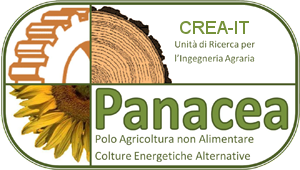Jatropha curcas (L.) is a small tree belonging to the Euphorbiaceae family, of tropical origin tropicale but currently widespread in Central and South America, Africa, India and South East Asia [1], where it can be used to control soil erosion or, more commonly, within farms as natural enclosure for animals [2]. Since it is toxic and inedible, it has been employed for ecological purposes as control of erosion, water balance, protection of biodiversity, air filtering without competing with the food chain or the soil availability for food crops. In addition, the specie can grow in marginal environments and with low levels of productive inputs. Recently the jatropha has been studied in several projects aimed at the promotion of alternative energy sources, because the oil extracted from its seeds can be easily converted for biodiesel production.
The jatropha could represent an interesting source of income for the developing countries where the plant may find the environmental conditions suitable for its growth.
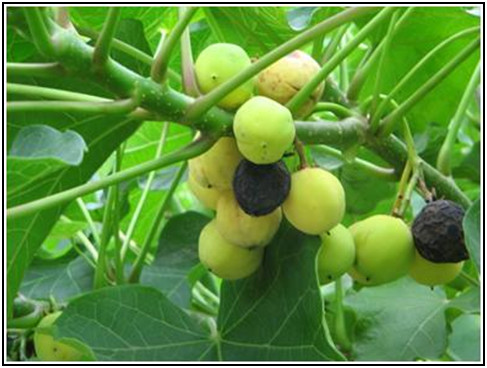 To date, the agronomic practices for its cultivation are still enough undefined. For a future energy destination, the harvesting may be the main bottleneck for its exploitation. From a physiological point of view the fruits ripen over a prolonged time. They are ready for harvest about 90 days after flowering when their color changes from green to yellow/brown.
To date, the agronomic practices for its cultivation are still enough undefined. For a future energy destination, the harvesting may be the main bottleneck for its exploitation. From a physiological point of view the fruits ripen over a prolonged time. They are ready for harvest about 90 days after flowering when their color changes from green to yellow/brown.
Both the yellow (which already contain ripe seeds) and the black fruits are ready to be harvested. In semi-arid regions, as is the case of North Africa, the ripening can last for two months requiring weekly harvesting. The yield variability, ranging from 0 to 850 grams of dry seed per plant per year (see Table below), negatively affects the profitability of cultivation.
The Panacea group is involved in the European project “Jatromed - Evaluation of the energy crop Jatropha curcas as a mean to promote renewable and sustainable energy for the Mediterranean region” (http://www.jatromed.aua.gr).
|
Source |
Yield (t/ha) |
Notes |
|
[5] |
0.4 – 12.0 |
None |
|
[2] |
0.1 – 8.0 |
Few information about variety, plantation age, rainfall, pruning. |
|
[6] |
2.0 – 3.0 |
Average yield in semi-arid condition |
|
[7] |
7.8 |
Optimal conditions |
|
[8] |
6.0 – 7.0 |
Good conditions |
|
[9] |
5.0 |
Good soil condition and high rainfall |
|
[10] |
1.0 |
Semi-arid condition (Andhra Pradesh, India) |
|
[11] |
1.25 |
Nashik (India) |
JatroMed is a 4-year demonstration project involving five countries from the Mediterranean region: Greece (project coordinator), Italy, Egypt, Morocco and Algeria. The main scope of the project is to reinforce and upgrade the natural and socioeconomic conditions of the target areas and to give local populations the opportunity to produce sustainable energy to cover their needs.
Aim of the present work is to illustrate the main harvesting systems (existing or under development) for Jatropha curcas L., as identified within the European project JatroMed by the Panacea group, to discuss the main pro and cons and to suggest the solutions deemed more appropriate for the agricultures of developing countries.
2 AVAILABLE SYSTEMS FOR JATROPHA FRUIT HARVESTING
2.1 Hand harvesting
Usually, the jatropha fruits are collected manually or with the aid of rods for reaching the ones placed in the higher parts of the plant. This grows between three and five meters in height, but, under favourable conditions, it can arrive at up to eight or ten meters. To limit the growth the plants are pruned adopting systems that increase the growth centers.
For years the manual harvesting has been the prevailing harvesting system, still remaining the most widely employed. The available data on daily field capacity show significant variations in function of factors as plant characteristics, variety, type of cultivation, yield and climate. Data reported in the Position Paper of the project FACT [8], in well-managed plantations the daily production can arrive to 40-70 kg per person, while in low yield plantation or areas of field hedges the picking rates goes down to 20-30 kg per person per day. This data emphasizes as the harvesting process may become a very labour-intensive process, with a high impact on the production costs of jatropha oil.
Importantly, harvesting jatropha is normally a women’s task (the fruit picking and opening) and often more technical tasks, such as agronomy practices, driving tractors and processing, are executed by men [12].
The manual harvesting can be considered valid in small plantations, allowing a highly selective collection, but the perspective of energy destination requires an improvement of field efficiency, reducing the work times and the effort for operators.
2.2 Full mechanical harvesting
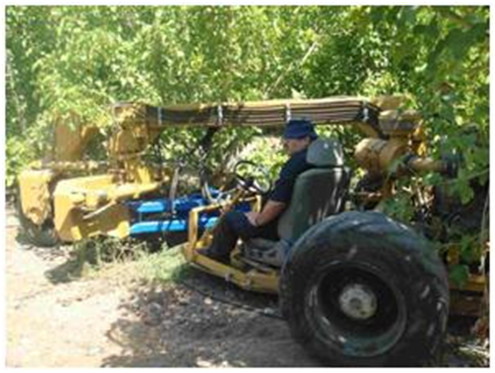 The factor that mainly influences the adoption of a fully mechanized harvesting is the type of plantation. Semi-arid, low-input systems should use wider spacing such as 3.0x2.0 m, 3.0x2.5 m or 3.0x3.0 m [13]. As stated by [14] the more appropriate plantation distances are 3 m between the rows and of 2.5 m between the plants, in order to assure a full access to the plants for the harvesting workers. In high density systems (about 1100 plants ha-1), suitable to hypothesize a mechanized harvesting of the fruits, the distance between plants must assure the absence of competition for light and space. Thus, it would be appropriate to maintain at least 4 m among the rows so that the distance within the row can be reduced to 1.5 m [15].
The factor that mainly influences the adoption of a fully mechanized harvesting is the type of plantation. Semi-arid, low-input systems should use wider spacing such as 3.0x2.0 m, 3.0x2.5 m or 3.0x3.0 m [13]. As stated by [14] the more appropriate plantation distances are 3 m between the rows and of 2.5 m between the plants, in order to assure a full access to the plants for the harvesting workers. In high density systems (about 1100 plants ha-1), suitable to hypothesize a mechanized harvesting of the fruits, the distance between plants must assure the absence of competition for light and space. Thus, it would be appropriate to maintain at least 4 m among the rows so that the distance within the row can be reduced to 1.5 m [15].
Several machines prototypes are currently being used but frequently a complete information on technical features is lacking. The Dotan Technologies is an Israeli company that has developed a trunk shaker that produces a vibration strong enough to bring down the ripe fruits in a selective manner.
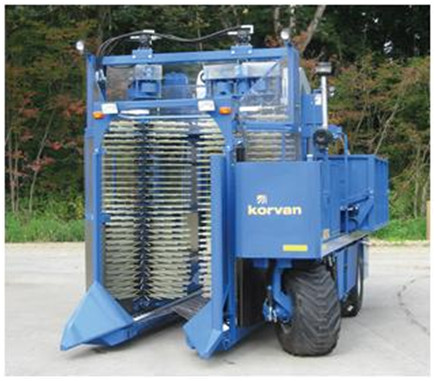 Other companies have designed commercial machines starting from grape harvesting machines also used in coffee plantations, suitably modified , generally equipped with systems of horizontal shaking . Among the models already used may be cited the Korvan 9240, developed by the U.S. House Oxbo Int.Corp. It is a self-propelled machine deriving from a modified coffee harvester, 3.5 m wide and with a total weight of 6.000 kg.
Other companies have designed commercial machines starting from grape harvesting machines also used in coffee plantations, suitably modified , generally equipped with systems of horizontal shaking . Among the models already used may be cited the Korvan 9240, developed by the U.S. House Oxbo Int.Corp. It is a self-propelled machine deriving from a modified coffee harvester, 3.5 m wide and with a total weight of 6.000 kg.
The Korvan possesses a large container capable to rake up to 500 kg of the product, a field capacity of 0.15-0.6 ha h-1 and a working speed of 1-3 km h-1 with a fuel consumption (specified by the company) ranging between 9 and 12 l h-1. For working, the machine requires growth systems with 3 m among the rows and plants spaced 1.5 m on the row, plants not higher than 3 m and a space for turning in the headland greater than 6 m. The trunk height is a crucial factor and the pruning should be aimed to shape the plants appropriately, avoiding the presence of multiple trunks, a situation that can lead to a reduction of the harvesting efficiency estimated about 25%.
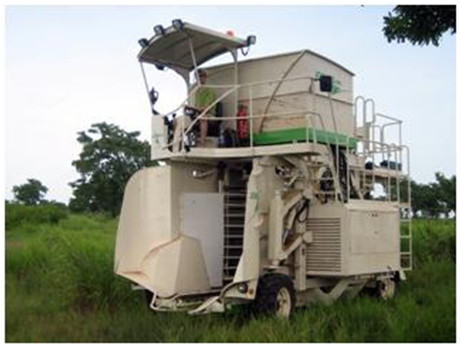 The model Joonas of the Finnish company Rakennustempo Oy Ltd is a harvester tested in Ghana between 2008 and 2010. As reported by the company, in these trials it showed a field capacity of 0.5-0.8 ha h-1, corresponding to the job of 100-150 manual workers. As for the previous implement, the height of the trunk should not be less than 0.5 m in order to obtain valuable performances, while the planting scheme should be 3.5 m x 1-1.5 m.
The model Joonas of the Finnish company Rakennustempo Oy Ltd is a harvester tested in Ghana between 2008 and 2010. As reported by the company, in these trials it showed a field capacity of 0.5-0.8 ha h-1, corresponding to the job of 100-150 manual workers. As for the previous implement, the height of the trunk should not be less than 0.5 m in order to obtain valuable performances, while the planting scheme should be 3.5 m x 1-1.5 m.
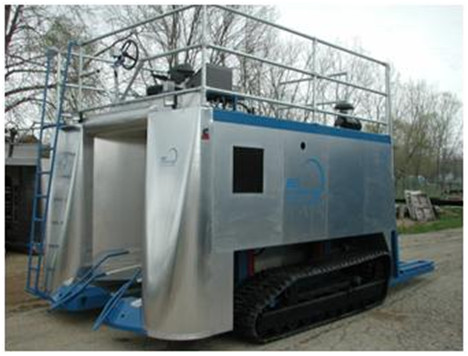 Finally, the Jatropha Wave Harvester the American BEI is a picker able to carry out a selective harvesting, dislodging the ripe fruit and leaving the immature ones to ripen for a later pass.
Finally, the Jatropha Wave Harvester the American BEI is a picker able to carry out a selective harvesting, dislodging the ripe fruit and leaving the immature ones to ripen for a later pass.
The field efficiency specified by the manufacturer is around 1 ha h-1 and the average fuel consumption is approximately 7.5 l h-1. The harvesting system used by the BEI, called CSS (Centipede Scale System) has been designed to minimize the plant damages. Even for the BEI, it is indispensable to operate in plantation having a defined scheme (1.5-2 m x 3 m) with plants not exceeding 2.5 m in height and on fields where the space for turning is at least 7.5 m. The machine can apply a dedicated kit designed for the mechanical pruning.
The mechanical harvesting can bring several advantages (greater efficiency, reduced effort for the workers, continuous harvesting, reduction of production costs), but at the same time the sustainability of the method is conditioned by several interconnected factors embracing the extension of the potential surfaces interested, the scale of processing, the socio-economic features of the area. Such implements are costly (150.000-200.000 $) and their introduction have to be carefully assessed through a proper cost-benefit analysis bearing in mind the social conditions (impact on local employment) , the economic sustainability of the investment and the influence on the agricultural sector with particular attention to land availability and food security.
Semi-mechanical harvesting
A good compromise between the hand picking and the full mechanization is the resorting to implements facilitating the harvesting. Such approach includes a large group of devices, with different shapes and functions, usually used throughout the Mediterranean region for the harvest of similar‐sized fruits as olive, walnut, apricot and cherry. These semi-mechanical systems cause the fruit detachment by shaking the branches or directly striking the fruits. They can be powered by an electric or gasoline engine or through a pneumatic system. The financial commitment for the purchasing and maintenance is reduced, their utilization is effortless and there is an improvement of harvesting efficiency compared with hand picking.
Concerning the jatropha, the availability of implements able to pick the fruits in a selective way is lacking, but two studies have identified the main factors involved in fruit removal by shaking the branches: the amplitude (mm) and the frequency (Hz). Being the plant of jatropha extremely elastic (0.332 GPa) and with a wood having low density (0.34 g cm-3), the amplitude of the shaking affects the frequency so that, the greater the amplitude used the lower the frequency required to detach the fruits [16]. Moreover, the vibration can be applied in every part of the branch without modify the result.
The physiological stage and morphological traits as ripening stage, length of the petiole, Preliminary tests carried out in Morocco by Panacea group within the JatroMed project on Mali variety showed little difference for the ratio FDF W-1 (Fruit Detachment Force/fruit weight) among ripe yellow (1.17 N kg-1) and green unripe (2.54 N kg-1) fruits, if compared with the values observed for other fruit trees [17, 18, 19].
Such outcome underlines as for the jatropha the identification of a suitable frequency and amplitude could be an hard task without assuring the full selectivity, because the fall of the ripe fruits will include a variable amount of green immature fruit having a similar FDF W-1 value. Despite the complexity linked to the frequency and amplitude determination, [16] found that in an range between 2.5 cm and 5.5 cm of amplitude, the application of frequencies between 1.4 Hz and 6,5 Hz led to the detachment of ripen fruits. Higher frequencies caused the fall of the green fruits, defoliation and plant damage. In a similar study, using an amplitude of 6.43 cm and a frequency of 2.2 Hz succeeded in dropping 74% of brown, 68% of yellow and only 3 % of green immature fruits [20].
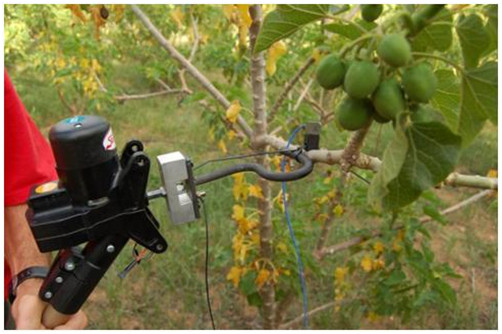 Panacea has carried out preliminary harvesting tests using electric beaters modified as shakers (figure 6). The first test results showed that the application of high frequencies cannot compensate for low values of amplitude. Future studies will analyze several aspects: the assessment of harvesting by means of beaters hitting directly the fruits; the shape and the materials of the rakes; the suitable speed of the beating device.
Panacea has carried out preliminary harvesting tests using electric beaters modified as shakers (figure 6). The first test results showed that the application of high frequencies cannot compensate for low values of amplitude. Future studies will analyze several aspects: the assessment of harvesting by means of beaters hitting directly the fruits; the shape and the materials of the rakes; the suitable speed of the beating device.
The potential economic opportunities for jatropha as an energy crop are particularly attractive, primarily for developing countries. For this to happen, however, actions are required on the genetic improvement (uneven ripening) and on the optimization of the cultivation technique (with particular reference to the fruit harvesting).
The growing interest for this crop has boosted up some companies toward the development of mechanical harvesting systems increasingly automated, thus improving the work efficiency, the work conditions for the operators and the harvesting costs. However, bearing in mind the distinctive traits of the species, adapted to the climates of developing countries for which could be a potential source of income, this issue is particularly sensitive. In fact, in the poor rural areas, the investment in mechanical harvesting and the maintenance of machineries is unacceptable and unsustainable. Moreover, one of the main forms of economic wage for rural populations is given by the work in the agricultural fields, that would be reduced in case of full mechanization. Accordingly, the introduction of technologically advanced machines may be in some cases very risky, from the point of view of both the long term efficiency (risk of breakage and no repairs) and the social aspects, since this would reduce the job availability, creating unemployment and instability. For this reasons, Panacea group approach can be considered a good compromise between full mechanical and hand harvesting. At the same time, it is an attempt to promote a sustainable mechanization suitable for the social context of developing countries with the concrete involvement of local populations. Given the morphological and physiological characteristics of the plant, the task is complex, but, faced with a correct rational and scientific approach, solvable, with a improvement of systems currently employed.
[1] L.M. Cano-Asseleih, R.A. Plumbly, P.J. Hylands. Purification and partial characterization of the hemagglutination from seeds of Jatropha curcas. Journal of Food Biochemistry, (1989), 13:1–20.
[2] J. Heller. Jatropha curcas L. Promoting the conservation and use of underutilized and neglected crops. Gatersleben, Germany/Rome, Italy: Institute of Plant Genetics and Crop Plant Research/International Plant Genetic Resources Institute (1996).
[3] M.M. Azam, A. Waris, N.M. Nahar. Prospects and potential of fatty acid methyl esters of some non-traditional seed oils for use as biodiesel in India. Biomass and Bioenergy, (2005), 29:293–302.
[4] A.K. Tiwari, A. Kumar, H. Raheman. Biodiesel production from Jatropha (Jatropha curcas) with high free fatty acids: an optimized process. Biomass and Bioenergy (2007), 31:569–75.
[5] K. Openshaw. A review of Jatropha curcas: an oil plant of unfulfilled promise. Biomass and Bioenergy, (2000), 19:1–15.
[6] D. N. Tewari. Jatropha and biodiesel. 1st ed. New Delhi: Ocean Books Ltd Jongschaap, R.E.E., Corré, W.J., Bindraban, P.S. & Brandenburg, W.A.. Claims and Facts on Jatropha curcas L. Wageningen, Plant Research International, (2007).
[7] R. E. E. Jongschaap, W. J.Corré, P. S. Bindraban, W. A. Brandenburg. Claims and Facts on Jatropha curcas L. , (2007).
[8] K. D. Ouwens, G. Francis, Y. J. Franken, W. Rijssenbeek, A. Riedacker, N. Foidl, P. Bindraban. Position paper on Jatropha curcas. State of the Art, small and Large Scale project development. Agronomy and genetics, (2007), 26-28.
[9] W.M.J. Achten, L. Verschot, Y.J. Franken, E. Mathijs, V.P. Singh, R. Aerts, B. Muys. Jatropha bio-diesel production and use. Biomass and Bioenergy , (2008), 32:1063-1084.
[10] S. Wani, T. K. Sreedevi, S. Marimuthu. Pro-poor biodiesel initiative for rehabilitating degraded drylands. In: International Consultation on Pro-poor Jatropha Development. 10–11 April, Rome, IFAD, (2008) (available at http://www.ifad.org/events/jatropha/).
[11] D. Ghokale. Jatropha: Experience of Agro-Forestry and Wasteland Development Foundation, Nashik, India. In: International Consultation on Pro-poor Jatropha Development. 10–11 April 2008, Rome, IFAD, (2008)(available at http://www.ifad.org/events/jatropha/).
[12] NL Agency. Jatropha Assessment. Agronomy, socio-economic issues, and ecology. 157 pp. NL Energy and Climate Change. The Netherlands, (2010).
[13] R. Brittaine, and N. Lutaladio. Jatropha: A Smallholder Bioenergy Crop The Potential for Pro-Poor Development - Integrated Crop Management. IFAD, FAO (Eds.), (2010), Vol. 8. ISBN 978-92-5-106438-2.
[14] R.K. Henning. The Jatropha System. An integrated approach of rural development. pp 105. Baganí Rothkreuz 11, D-88138 Weissensberg, Germany, (2009). (www.Jatropha.de).
[15] M. Paramathma, K.T. Parthiban, and K.S. Neelakantan. Jatropha curcas. Forest College & Research Instiute, Tamil Nadu Agricultural University, Coimbatore, (2004), 48p.
[16] M. R. H. Ramli, M. N. A. Ghani, M. H. Razali, F. I. A. Wahab, N. Ngah. Determination of vibration properties of Jatropha curcas for mechanical harvesting operations. Songklanakarin J. Sci. Technol, (2011), 34 (1), 9-15
[17] R. Polat, M. Güner, E. Dursun, D. Erdogan, I. Gezer, H. I. C. Bilim. Mechanical harvesting of almond with inertia type limb shaker. Asian Journal of Plant Science, (2007) 6(3): 528-532.
[18] R. Polat, I. Gezer, M. Güner, E. Dursun, D. Erdogan, H. I. C. Bilim. Mechanical harvesting of pistachio nuts. Journal of food engineering, (2007), 79: 1131-1135.
[19] A. Sessiz, M. T. Özcan. Olive removal with pneumatic branch shaker and abscission chemical. Journal of food engineering, (2006), 76: 148-153.
[20] S. Hong. Study of a harvesting mechanization method for Jatropha curcas L. using nonlinear optimization, (2011), pp 140. University of California, Davis. Thesis.
